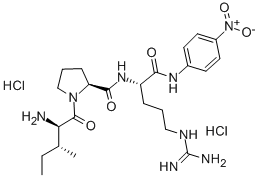D-ILE-PRO-ARG P-NITROANILIDE DIHYDROCHLORIDE CAS#: 96323-41-0; ChemWhat Code: 1324771
Identification
Physical Data
| Appearance | Crystalline solid |
Spectra
No data available
Route of Synthesis (ROS)
No data available
Safety and Hazards
| Pictogram(s) |   |
| Signal | Warning |
| GHS Hazard Statements | H302 (100%): Harmful if swallowed [Warning Acute toxicity, oral] H312 (100%): Harmful in contact with skin [Warning Acute toxicity, dermal] H315 (100%): Causes skin irritation [Warning Skin corrosion/irritation] H319 (100%): Causes serious eye irritation [Warning Serious eye damage/eye irritation] H332 (100%): Harmful if inhaled [Warning Acute toxicity, inhalation] H335 (100%): May cause respiratory irritation [Warning Specific target organ toxicity, single exposure; Respiratory tract irritation] H361 (97.5%): Suspected of damaging fertility or the unborn child [Warning Reproductive toxicity] H373 (100%): May causes damage to organs through prolonged or repeated exposure [Warning Specific target organ toxicity, repeated exposure] |
| Precautionary Statement Codes | P203, P260, P261, P264, P264+P265, P270, P271, P280, P301+P317, P302+P352, P304+P340, P305+P351+P338, P317, P318, P319, P321, P330, P332+P317, P337+P317, P362+P364, P403+P233, P405, and P501 (The corresponding statement to each P-code can be found at the GHS Classification page.) |
Other Data
| Transportation | Low temperature storage and transportation |
| Storage | Low temperature storage and transportation |
| Shelf Life | 2 years |
| Druglikeness | |
| Lipinski rules component | |
| Molecular Weight | 577.511 |
| logP | 1.847 |
| HBA | 10 |
| HBD | 6 |
| Matching Lipinski Rules | 2 |
| Veber rules component | |
| Polar Surface Area (PSA) | 212.25 |
| Rotatable Bond (RotB) | 16 |
| Matching Veber Rules | 0 |
Buy Reagent | |
| No reagent supplier? | Send quick inquiry to ChemWhat |
| Want to be listed here as a reagent supplier? (Paid service) | Click here to contact ChemWhat |
Approved Manufacturers | |
| Watson Bio Ltd | https://www.watson-bio.com/ |
| Want to be listed as an approved manufacturer (Requires approvement)? | Please download and fill out this form and send back to approved-manufacturers@chemwhat.com |
Other Suppliers | |
| Watson International Limited | Visit Watson Official Website |
Contact Us for Other Help | |
| Contact us for other information or services | Click here to contact ChemWhat |


